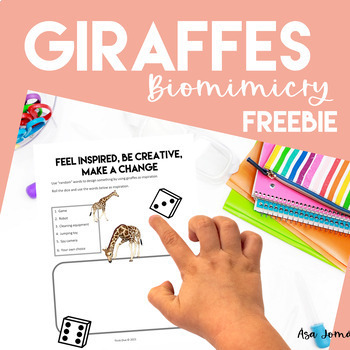- PDF
- Easel Activity
- Easel Assessment
Description
Looking for exciting activities for a project-based learning unit? Here is a biomimicry Freebie to make your science project for younger students, Kindergarten to Grade 3, both fun and educational. By incorporating elements of biomimicry, students will be inspired to draw parallels between nature's marvels and innovative design solutions, nurturing creativity and critical thinking.
If you've never used biomimicry before this lesson plan will guide you through the process of using biomimicry and steam activities. Using this resource is a great way to inspire students to ask questions, study animals and use creative thinking to explore ideas. Biomimicry is based on the idea that students can take inspiration from nature when solving problems. Your students will love learning and exploring this innovative approach to problem-solving.
Feel inspired, Be Creative and Make Change.
Giraffes have long necks and long dark tongues. They are endangered fascinating gentle giants. Here they inspire new ideas. Discover the enchanting world of giraffes with this captivating freebie, designed to immerse students in a multifaceted learning experience. You’ll find everything you need to feel inspired, get creative and engage young students.
You'll save time by downloading this easy-to-use introduction to Biomimicry - Bio means Life and Mimic means to imitate life and nature.
What are you waiting for? Download this fun, educational and engaging biomimicry resource now and give your students a science activity they'll love.
This resource has been prepared so your students can use it on digital devices. I have selected suitable slides for you, you need to insert text boxes and you can also add instructions for your students. There is also a short assessment with a couple of questions.
You may also like:
Giraffe Project | Life Cycle | Biomimicry Design Activities | Nonfiction
African Animals Project | Biomimicry Design Activities | Nonfiction
Also, Follow Me and be notified when new products are uploaded. New products are always 50% off for the first 72 hours they are posted.
Reviews of other Think Dive - Sparking Children's Thinkibility products:
Project based learning: Bats, STEAM, Biomimicry
"This product is absolutely the favorite one I have purchased all fall! I love the information that is provided about bats - just enough to intrigue and encourage higher level thinking. There are graphic organizers, worksheets, and subtle suggestions to help young learners perform at their best! And best of all, it stretches their creativity! Thanks for such an amazing resource!"
Project based learning: Mammals, Reptiles & Amphibians - STEAM, Biomimicry, NGSS
"Used this for a Kindergarten STEAM club unit and it was a hit!"
Why am I qualified to write these biomimicry resources? I was a member of BEN - Biomimicry Education Network - and a curator of educational resources at BEN. I am the author of the book Biomimicry with Theo & Tuva: Nature spotting inspires wild ideas. In 2015, I completed a course in Biomimicry: A Sustainable Design Methodology at Minneapolis College of Art and Design. I took part in the Biomimicry Design Challenge in 2021.
Product Format:
• This download is a PDF and is formatted in US Letter size. If you would prefer an alternate sizing, A4 size or spelling (colour vs color etc.), please leave me a note in the ‘ask a question section of my store'.
#projectbasedlearning #animals #giraffe #STEAM #STEM #NGSS #biomimicry #designinspirednature #scienceproject #FREEBIE #activity #activities #nonfiction #sparkingchildrensthinkibility #thinkdive #asajomard #digitalactivities






